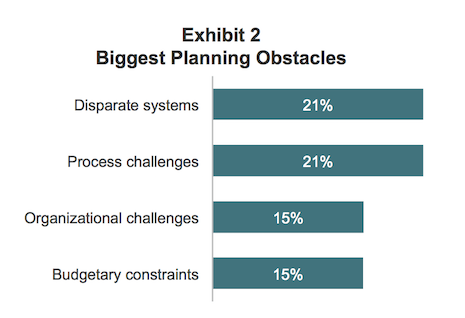As data collection technologies progress, retailers are finding more reason to expand their analytics abilities, something in which luxury retailers can benefit.
According to a report from Boston Retail Partners, 44 percent of retailers think that analytics is a major priority in the future. Additionally, more than 82 percent identified the need to improve their planning systems to act on data analytics as something that they need to focus on in the future.
“Luxury brands face a few unique challenges around analytics," said Gene Bornac, vice president at BRP, Boston. "The main challenge is the smaller data set.
"Luxury brands sell to fewer customers at higher prices," he said. "Unfortunately, analytics work better with larger numbers.
"That being said, luxury retailers generally tend to know their customers better and can utilize that information to improve their results from data analysis."
Data collection
Data collection has become an important part of brand strategies in the modern era.
This fact can be attributed partially to the rise of ubiquitous mobile devices that give every consumer a digital touchpoint wherever they go.
Using a variety of different options, such as beacons or WiFi tracking, retailers can use mobile devices to track how many people enter the store, how long they stay and other relevant data points.
But while the capacity for data collection has grown, what is most important for retailers is the ability to make that data actionable.

Only 17 percent of retailers get real-time sales data
This was the subject of BRP’s latest research report, which surveyed retailers’ views on data analytics to diagnose exactly how brands feel about data analytics and what things are standing in the way of making it more viable in strategizing.
The surveyed retailers’ ability to act on the data they collected lagged behind their abilities to collect it at all. But many had trouble with collecting at all.
Only 17 percent of retailers receive sales data in real time as transactions happen on the floor.
Luxury brands, due to their high-profile nature, need to be able to provide a more consistent and coherent experience to their in-store customers, and a big part of that is collecting data and acting on it in an intelligent way.
Small sample sizes
For larger retailers such as Walmart or Best Buy, collecting this data is not a problem as they got thousands of customers each day at many of their locations.
Luxury on the other hand has a more difficult obstacle to surmount: the low sample size.
Retailers that sell luxury products, by definition, serve a smaller segment of the population. This means that with fewer people coming in, there is less data to collect as well as a higher propensity to have the data skewed by outliers.
But luxury retailers can alleviate these pressures in a few ways.
For one, they can work on making the data that they do collect as comprehensive as possible. One solution is to use WiFi, which is more reliable than beacons, for mobile data collection in-store.

Disorganized or conflicting systems prevent optimal data collection
WiFi, once the dominant in-store location technology, has seen its role come under attack from newer, less-expensive solutions such as beacons. However, WiFi’s broader reach along with recent advancements that make it more cost efficient and accurate, underscore its ongoing relevance (see story).
Accurately tracking traffic and determining how it relates to conversions is a key to sustaining in-store revenue, yet many retailers have not equipped themselves or their employees with the tools to determine and act upon these relationships. In-store remains a crucial part of a retailer’s strategy even as numbers fall, but brands must first make use of the data they already have before they can improve (see story).
Luxury brands that make the most of the data they can collect should be able to circumvent the problems presented by a small sample size.
“Like all brands, luxury brands benefit the most from pulling all of their data together," BRP's Mr. Bornac said. "Using the advantage that they have with their customer relationships, they can create a real-time view of their customers' needs and business opportunities."
{"ct":"j34ic2mrmKFLLqE1+U5yw3td7ZvYkTz57J1MFJJRZC7So2zbKaODN\/4NuV8mcXn\/8SghlE8C9iGdv1XaLlZH+czmtFXuFDM5B832HKOTFLF6dWBcIFK3WOMXBv\/lwFEZjtCvfaKuO5Nn5ax2xGFUDS5FYASv2eay+ToqgS7Cfq4EaLBFRXDkXRstj0oUChoOsX2NFjfD5tLCFKxBd0NpGUObCwq1YHAWambqTeyitB3KenNWVnCQArmmBJTi2zyiM0KVM4fNHbUXFsDL1Phq7wVebpgEFN6eR4k9aaKLrGAqYSdo1Fn6snyOn8G2s96s+aYwH+CEEjJqR+1DC2DZUbFhtg8+FrMRH7RUjyn0kfODi7qGXCnDZp4CO7C\/7Q6whVtfG5LjOOCqsiHCSlXNZXnDgz7lll2bHi4+iL5O9QRpp1BlDwuQXgPLz6wUOo43fSuNgjwXw2YX\/TeBN4Xne9\/QI1F14rmQmIBcpvUZks+9u\/kyJiUH5W3Ll2AvQDFRRVKmgodAJg2DnB+rD2xeUnHr\/Sou8VIN25uqIIxlHMsz5NAuQsH+X53usmYJEcOiYNEgEKeQB9KDmcpHX8LQ6pyAas4D3r1\/IEndqhDb\/nN8EpPE4Xkg1CRYYcofzrRzmDThRdVu+qRaEX6oJGIcnvcLQVBFj49mv8HX56UFg\/IANpbwWxS+n7IYOHKXxxqmV\/IYlJ7fUnJO5SXWD+pHBRBIQKnxAX4+0N3x8\/mATIkuthfxqYhrh0XAzxqr83W0rplF6h40\/bXir5C3\/gpJMwnCD4IgzwZIAEtSjjD4MfThNXQ87FUfjazMAnj8wRD3xQ8kwtDXQ1lv5pBkB3ZrOCRfFpmEvaCcFncin6EBHNkBvTA0GrojqhTr0LMXD+YgXGjnrMHBGE2ya\/vWoeLLW4zwq1QC2toWq6bhuTB2SrWjCeYOVqX4Qts3Ulc0GFI4x3c6a1C\/yo6NbN\/s23yWOgYJwjKsV60JcpOWT2qEaJp+M94q1yIBNyPA0S8h+PHWmVe6XUB4zDLoTvWqfOxwAUFRK4Ose18emPMzgwjRgtwxDDcibwc5JhTQ0VMU1qynml\/zsseZefvaEVM6SY0uT559+jifbWg9Zf6qrfOyHv\/Z2lRLH\/PDnjWitGKcoSWm1mSsdJXq2HgXWCxVCXbq5ESR+88U14wmNWLz1aBHAw8\/RmxWUbgrNhiUGtYQjhag+LKXyp3EkezVmj5B37FAsRYBZK+GNvPZqTpld1YmuX1Z0Qmwxy6e1D9AB3Zeh0+i2GmqXAT0ew02ljBbXy2XoiTZt92bRNM2KTjmxogH7QJWWQLB77MYjiZsxHRNAGmNezW7ty237+xaifyuME+ooIWbumS39jkRuHA3XS946rFEyLUd60bHcFvlyFysupX1nYHu2n6nrcverw+Gmwr\/UyY0BgDVve0umCB9RXet9bbTTjX9334F1KHfa11R7JzwmL+AI9hSu3eoblCCUJ6yYOYqu4pZPB4GCgA9ZLuowdqwemQLOsYMjsCAlgyw9TPBf2IBJGVhlXZufVtxD9biru1YGKYYsv0GPCqNJifn0nYSiNmpCidC03dBXEUdZrGMiB7c4tFBF6fUXs\/3us0u0tko4KQggvx8y3XsomlZVEXuquO8EMsGqe4cY2FtMuEuNgrCONiN23ydmCvRoHPSNVksQ+Ase1ce1ySkTEMRLdvYjXe1+OxgbvPuAlSlD3rDQLwm6se6DA120O8ODtsAyC\/PmXACAdMoHmPg+oj3CMsBuabnl\/51h4CRVq1c4z6DNBS9KDjGSOblXNDF5JmUwhmsuNnDkA3h\/KnTFDMtKgs0r6pE6RhylVL5FT\/LIoyz8yznEUnKMJe0SNrfsutRF3vfUouPJ0bTLg1iIZR7B7mL9rchM2eAkD4wzNhrTlq+G1auFYhiwA5Yban5Htz1MMpq8i6\/Gdt43\/0lYBcUrDD+MmP5N3u3f8rkbtt1uKf\/cQL3mhbkG1N674AxEfhn4u58gD+CgKSfQKHa1yQ537fM5YEMFFcZ4gzZwE\/ksOl6Bwxmrtg1q2jgDK8+l0syovZLu1SEiu6YsOCvxvL+MaBbVL5miuNQe1T4w\/c8Z4YktQ03tecptC2R5XGt\/lDhT24L7TDHeI5vIXpztDWzW1K1csclOkTbMY21UMVeY15J+jhY70zb42eI9kfplfHPWZTxGjjHuWfi1SCnryzPlFEwdeAD+32hS1n4rDDGinuw\/iGzozbw56n8x695QpB0JewHwvBQha4HiphtnwYnSbdX9fe8BcaZeeNs1jXhxVHVEI8Kez+LPmBc3TLDf+gnx7hpFMWEUYEsKdY+\/NICa\/PFO\/Ik9hUToKoSh4J\/pF4vhyRCVckMSQKrhJhLBzK3i18I3z\/OLgavRxEQtGhIN4+WtR6UVp8cibeWsTY\/aqEutJQUkXtPCxFDcImnrs4Lh0H0LcpjHXCvJbFUyUmJqpA7dK3vG3DL8niMcVuV0hhoyeFnUxXYQ4Jj2LcwgKfjJ3IQUZKnccMGQa\/rYKlwUuXVsuiXtMRnucco5iJtmmh1EFwn7U0qzFmhy8nZH4h+vQtgwfnaPRlBahZFrWwgUD7N8wOpuqxzz+toyEj9tnGB1zUcFLiYqvOz99oJyW6Q+khAXivEE7FTyr1sUGvqb+ncoNMqYCsizbhHeUQkCHOAO5pxIEk2UjeoKPJc1mrX\/57+TnWGq1KswrL3\/Nq55ZXMTqmfvyREY8j7iyrpivQ6Se1qc98Bgiv3HJC2KzboN\/GDkeslu1ELtSXUM7FoITFVCAUGqjZsz2+gnm3GAJzN2sHVmCBC+tSyPZi9T9tMBFWIHc+k4uaCH8FMnUSexRleugNs23jMz7vZjYEf5GCQkF6SFM\/EKk+ssEuj7Qac18g11HDE5TQ6dF2CXWSq1x+JsMF45VHwVijiHMDWWOEbWUdE+uQWsdOs31zugT1z3QzV+jsOWnMLcA9u9Bt81v2AMMDPiwM73z+qd6PXZIVzH1y3EZFtCymQiSKB9shJoM+ZwQg+EHdrw8YRehBMlpjV2xFkij\/xoJwdRcCdxloPMAGRd\/ZJNgb0uoYTi+GLcl3RmPaToPaJvxbgv8EvfvG1q1LR+Dr+7hsSVEZy23n2moLKvIYM5+lfDsn7miZMeQL1npXqVPZEK8DESFnfjKYbtArT1IPwrVoIn4BMDBvxQ\/DrjdEY7KPjZm1ijkPf39hcZSbjfRgcqiHhRTxMTNDQfEOYBx5SmyYfka3bFp0hBhBu0d8Tv05NEiLvcwxkAEHTMevafnsdvUVcowWxX0OMw1djPuO1sQd1mvuU4oZSx4VKGmGawlJmw7AU0YFaQKu78YMMwZaBLiQfzVnjsf4Ie1Vl9fHSu+mcp0mpzbCy3ZYcdQE6N3qqBo4sytw\/BAH\/6pExZquM7\/jQ0zXauV01z8xW2nvxgCww28zkrfKXuGoSLWIWCAQatp9eIv8HZnlZ81BIS4NTiDAHoWxvuj7jAM2LBXJKvMHjcuYUsB6gNMS6UCicG57nvOL9DS+z5HtLaAkelKNYfXQ3CqaGbEgYuR4oqOhFtt\/w0pfVqg\/Agw0H+IpGxikA84L10B7duqu4AkcGKJDJp9+1MK4IqXzmPNOYMlnbJyfg3Is\/fc4igAX6U9bBpsaKNiI00M8ijCRWLCrpNwYbs0svkzUsRCFLNekctIgKYppsPKJu9flu8dzPlzyJykJXzYgAbHeqcxMGTec2HmZcjYVeSME97he\/8gVa6FvhOQXuaWC2VdIZKszG9KkKESdqyb5Z3h9QZKZ6n6whVPRrKC51LqH0jj76HnSnwU4Go6SezZOxA40YCSbuePlMVr\/1Frz2KRFt1IrfwVW5D5FVYytARTa+4nW981OQGIb3F9da8yCginXtdVAhaC3Ir6izV0BOSX19KQ+nLM9NR0Nw1dv4N2LU4KOJcJ4\/SvMyJfO7EJZc6wQnucQkptMMOLOrODfwNYqWyxHYvOoFBXZrwzrO9gcmp7SnOS8BF4pA6jjOiTQLQzrJqoggwG2iiXQ8bc5+WT3LjhHYChWxmxglz9foqvdiPCfC74FfMVT8CAbKTEflYjrKAhQExUBCVrx2TaKrxEe+Zepy8xpLHnAJDrpUX5vpQno5MqoSB0BALRt5cLgeQIZQJkIdjEC7+faaoQWbMZIdxO0ZrRd5jsIxLGCQ8SW\/VQNj4\/naqwGS0RnCc7IhJdAyKSNnb2U6ws93MjBWIBxn6a58TSWcRJeOCQzKUQvTHeGJxEcNsBvXhrUajt3CKA3EsLyuWS0tUMvlfklxwbbrg95LqnQoNjEkt+mplrsvCRkWWW2rh\/NUpnyeKYRAhEHfPWXMr3cyY8GR8cPkhWiIxmdZG1HtbuxKvkoDcble2h++cIZGvtKp2K3HtHnlh7RC4BHnqiY2x\/pMBmjIDaq\/TLVQgU94\/cTbh4D0fDmORpiOT4i2Zo0nfiE+cMzjklxWhX4xcWIKBVOLvKgJXiffHKqTHYZVAgrjaWoai1kZMKGkgoJCK+ednL51CGNAnmRm2yoCqFNBHrCngRRsC0w3FRu25N+kLFue0+qAwrRIEmAzqtf24SYbwwP6vKzlwJvQk35pD8pFHL9jWGFl+Uifd4hbWzXYMbvRnMPyOoQdlcLCNikx7SsmF1DoalG7zMOt7Ksushn0BMWcN36gPZ3ouvTRgGysT+ibmI3ylIbNm5tcU0T07KU+m7bZSpFmXWHIGFEhpPADr4I3hLJrOv\/luOsP5iBauDRyrEIFRKZQYtN1H6a4\/d31k90ZmT\/RX74mfxFLtpMASUYwJYPGXOUMW204K+JM8vz4dt6GqvMudw33GEhxMbUkdVbNEC0QNbqfxvoM2D0URzUp+7XV8x1EXWA\/2UKu6hZuYaA+t0OkDLYGFtT7HP0j41bAQEXlnlcaI8a5+8ZgdgbAne0FA3DmtqgwxEkWkF2JQo8i+4O7LuymedeuZxR5WC8jyfWjzyJGfp6izFZqoajkvkQJCfsNVHVCOYVkSk9xpAGpyWS4NuwHD\/zsKajcyWS+UdLxch3mOmwAS+wpgHP\/tDnvVKajE8auD2\/j0f\/VUl8Mm1DbUTJ58FkvJdHDDPtxNMDnEk0aPy+qcyPiLbtMea0De3XERd5FWl8ki\/iJ73satk74d7NcV4fwFXkHyXsyfQ30GhzbI141gF+5mOHiMznAYWdJXiV9qxxsRuQqeNpDpQpl6EMC2Sr4PZoghPfD8jGD8t2lb2\/yIbub3ZZM7jC0I+UhVDELbip3gdZ2EFS9zI+e9HlVlFHWgJy6RsID6z7EaW+GV4cOdv8vEBGskC7FLSy+YtFrTyBFAyKXrNG5Gro8ENw7+DfKvX29whDSwurLD6dD5eAGjtgWvcjOD8PrRL5MhGlGxSIvLzLz6P\/EnXiGJP12BImHzRV8Fqx2m5IbLogV0yRGEDkhPXs+8vFGWh9mLnWsdmxhTeVzXbouMiQAakzIXZoOkfyL36ksFJxty404xx\/eV1J0La6S55BspNZ7kprKYEpEoLICbvYdFhdjB91Mv8gp5DmVhIOZab+0kDV2QAiNYNKOBsquSKI3i2Ua8Ki6jM7jA14n4rsCQXdjaVVaYgs\/ebpQ9cZBG6eiqqjRUaUpM4M1wmUHol3\/zAW3ySfB1ZY\/qMutwxrBFADQHvSV4Tk89SdRHTQ3ndt2+hvIVdI7hRI77R1eBxjE9QPsZ29Zg5ETRxlguhuDowznmCH\/Eqvx3IuIkR0T27mbU+SRh4g+7qOpNKalY0cnzA3GeoUsTxuTcF5u+2mxahdwaI\/MpUqvnyztyHtulzK8ksLeRK\/zcvFxpo3Z8gUtfP1zWASYY\/FLUXHjFo55Qn+JxFmFPa0aif9YBT84H7S8cSOdb2z56ef3EN207GEV+rQIiSxt0KL7Nt+xsxLrinN\/2mwoSmHHBAsMTBk\/u9Ejzcz2met3KYkrYkEM5JZWP6KadaiQBlJMnqD0FilgJzR2efQ0yKo5XeSfKlNIhF6TyIKArRf6oo4sz9sQIKZg3suFme2rKZ39m9GXi33jrW572i0r+sVCFcCNdw0hzQ73H4abN5s6oBIjJgpVFRmWN4BjrNTu0nYiVYMzJAQ3IQ44oNi69KtfMVcjoU5CaMUvt1pYPZE\/7ZChPa+pNXderCe621pqYxkUcHCXDOYwdOz7aID21j2zWp9+\/1TIF8YJkbox7Hzu9Jit8mWMF22hg1DV6q2dxKSjqdDSyBXu\/rvzxB7TnE949BDTIW9T8AuvJN2\/BjlVG4Kh+a4lrwUvYp6SG8cvEMTxGXxqgSBvtkbLgUdS5u9EFKojyk+UcWXVdi4wycxpZk0jq8p\/tjK+EDkbpDbN80VbsTG1L1MD6FKRLaqmnMdmrbUl6z06PVgMWzTP2YUV49ZnoIkEhn7QF7oVbbRmPDpkfi8pv8NP0yGpYqsNumGtXEs39\/LPF5fjklatTooyt9dI3+2ihHxCX6DLBMXMxTjMBtzBOOshLsOKp3l\/OhovMw2bLnF\/0JlJvQOm\/9ePXxQMm80BN0fcoB943fVCBevlRF2yoFILybn\/assZVQHR+mfFS8BNYvQ020TPRp7wXRcVVwTEUdX16vNGxUKOc8Fr\/rcqSfL4x9go7LSdZhunBWpZRl6b43J3AgMv+tXnuTl78YjWqjrCcQ66lOG42I9NoYhlC8i4eNQem6Qaqjp66vkKul4em68Yx79RCgHduBcup2YMD1XjLBWObzC8qqRwIVIkv1BXMilLj74UMLAqWm\/0Osf8AYTthw4F4HzrRzimnwNVJ3vM8wwvGIzjhqQIR1W0Tw2JQYsZYcCvDo1Z0IfSpDefmSQ7BVCubQA8zPfX5wi\/8o7CS1mp9TCM0DJ5MVdwru81vVKojOcjyYXea5+BsRSyy0bipqHEK1v7alHERKqCHVOMZEqN67QnqXZfmVBZIOmeTgVBhTsEo8wIC5lD1X6MD6VKks6CbJC3aP64iIy3tNN5ZfO8VVxMGL4z9BBJMhjdlVzfTpGDn0mToOJf6Rmz\/+16U3RFJylVgBpP4moEhJk3dhZDEonhtY8+9F\/VJIrP8fazb23LkYFfd2Uz5dki5KSRFTRQsKjEt3btX7vCXD3JmRm9Xw6gAIPC3OdlOzH204t5Vv2WrmIUlcXTcqSqyRA84weh6l0itZbZJoSXM3ZMVY04rItxGknuWVLrSTJbDcmiGXqzt4ZYNaxe3DZ18Jb931qVEUz9WFNF5WDe3rIlg0kW+RkzEaxT9UecmOVftu8CJXOWqPPKDX14k0ylmFZgMbL\/0UQM79cGdbQIJFXunLazSDxvuD+4C1NpXxJn2mQABfy6mggKN2KgoNfiFDi\/mA4zlunSlPvBmqFpOhq+LkhUfftKDAiZC1dEhGu9NL3zboWPvBzF76kqniIrPRikwdIKqsXUO1xH91oqo2xxS2tZNJq3D28mtprr3ZH\/3f88WodqD+5utkxXEyaFjTJHABJJ3x9aJePHifdoq3PBy2i18sC46LaNxslYdRcDBds9c1kiz8eon9ZjfKx4\/I7siS\/bbSSXckPqkPk3dXHq8I\/ziAKDLlkNfJHlT3YKxtSp\/DvYQ7PF0Jqg8oHGSYW3y5Q+9P9V+nge1VSHYDReyVD4gFT4xuNmITxe8+7tu8+Tfw7xFDI5sztwkIeXaa4h0mKkuWpQoHtq2bnLcEEYhVsPaZA4SLRKaEF0yYzewVmSVETfUkSY6lU7q2WU14KqANTpGHdQ2RmCzPL2i3jhO1MuvIxFz6EgP7sX2ibL5AwSBfGhNKDf9fduR4Ol6Wiowm57AVofrJYA0EJM5PtCmoZjG41aSgKmlFbYbfUw\/X3Kzgc=","iv":"5dbc8801a87e913ed51baa80d47e08c3","s":"d8b9e406d4668f2c"}

 Luxury retailers need to optimize data analytics
Luxury retailers need to optimize data analytics